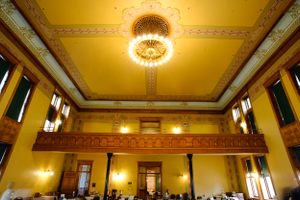About
Above the altar at Calvary Cathedral are eight tall stained-glass windows that shine brightly in the morning sun. The images they depict are traditional ones—baptism, the last supper, the crucifixion—but look closer and something seems amiss. Below an image of Jesus blessing a child is a memorial pane with its inscription laboriously scratched out. Next to it, a depiction of the Ascension received the same treatment, though the destruction is obscured by the pinnacle of the altar. And a third, showing the crucifixion, has a memorial plate that an expert says is not original to the window.
The three windows were donated to the Episcopal church in 1891 by Margaret De Stuers, a niece of the Astor family, one of New York’s wealthiest and most influential at the turn of the century. That influence reached all the way to Sioux Falls, South Dakota: Charlotte Augusta Astor, De Stuers’ aunt, helped to fund Bishop William Hobart Hare’s missionary work among the Indigenous people in the region in the 19th century. After her death, her husband, John Jacob Astor III, had donated a substantial sum to Bishop Hare to build the cathedral—at the time, it was known as St. Augusta Cathedral.
Margaret De Stuers had a more scandalous connection to Sioux Falls: she had come to the city seeking a divorce. In the early 1890s, Sioux Falls was home to the “divorce colony,” a collection of unhappy spouses seeking their freedom in South Dakota because it had some of the laxest divorce laws in the country. Bishop Hare was vocally opposed to divorce and vowed to eradicate the colony, and he was angered by De Stuers’ divorce—and her rapid remarriage. He wanted to refuse her generous donation: “I won’t have them,” Hare insisted of the windows. “I’d as lief”— gladly— “paste up the flaming placards of a low circus.”
The window depicting the crucifixion was installed in the 1890s with Hare’s blessing—the memorial plate De Stuers commissioned was replaced with one honoring Charles Smith Cook, a man of Sioux heritage who had been ordained by the Episcopal Church. The other two windows with the defaced memorial plates were found in storage after Hare’s death. From the pews of Calvary Cathedral today, you can just make out a few letters of the inscription below the image of Jesus with the children. It is the name of Mary Alida, Margaret De Stuers’ beloved daughter, who died at the age of eight.
Related Tags
Know Before You Go
The windows can most easily be seen by respectfully attending a regular service.
Community Contributors
Added By
Published
June 13, 2022































